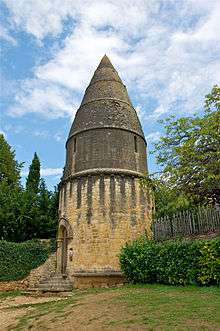Lanterns of the Dead

Lanterns of the Dead (French: Lanternes des morts) are small stone towers found chiefly in the centre and west of France, pierced with small openings at the top, where a light was exhibited at night to indicate the position of a cemetery.
These towers were usually circular, with a small entrance in the lower part giving access to the interior, so as to raise the lamps by a pulley to the required height. One of the most perfect in France is that at Cellefrouin (Charente), which consists of a series of eight attached semicircular shafts, raised on a pedestal, and is crowned with a conical roof decorated with fir cones; it has only one aperture, towards the main road. Other examples exist at Ciron (Indre) and Antigny (Vienne).
There is one surviving example in England, in the churchyard at Bisley, Gloucestershire, which is referred to as the Poor Souls' Light.
Misconceptions
The origin and use of such lanterns are controversial. Some of those lanterns are said to be "lanterns of the Moors" instead of "lanterns of the Dead". The illiteracy of most of the population in the past can easily explain this folk etymology: in French, "the Moors" (les Maures) and "the dead" (les morts) are near-homophones. Moreover, some of those lanterns do not indicate any cemetery and their architecture has strong oriental influences. The proximity of Al-Andalus, Crusaders coming back to France, or trade in the Mediterranean may explain such monuments. For instance, the "lantern of the Moors"[1] in Vergèze, southern France, looks like the chimneys[2] of the Bakhchisaray Palace, the Palace of the Crimean Tatars in Crimea, and doesn't indicate any cemetery. Actually, its other name is indeed the "Saracen chimney".[3] The "lantern of the Dead" of Carlux, Southern France, is called a "Saracen chimney"[4] too. Another example is the "lantern of the Moors" in Sarlat-la-Canéda, in Southern France too. The origin of the lantern is linked with the abbot Bernard of Clairvaux, who played a major role in the Second Crusade.[5] It is said to have been built after a visit of the abbot in the city, in 1147, possibly by Knights Templar as would prove a sculpture on the tower representing a horse and two Crosses pattée.[6]
Besides, "Saracen chimneys" (Cheminées sarrasines) are a typical local architecture feature of Bresse, a region in Eastern France. It seems to bear the same name only coincidentally. And the origin of the name remains a mystery in that case too. Various fanciful origins exist for those who introduced this tradition, such as: survivors from the Battle of Tours (during which Charles Martel fought the Saracens in 732, 350 km and many centuries away), refugees from the Balkans fleeing the Ottoman Turks in the 15th century after the Fall of Constantinople, Burgundians settling in Bresse in the 5th-6th century and carrying with them Nordic-style chimneys, or monk-soldiers of the 12th century. Last given explanation, "Saracen", or "Arab" also meant "apocryphal" in the 19th century.[7]
References
- ↑ Archived November 15, 2008, at the Wayback Machine.
- ↑ "Photographic image" (JPG). Hot-tour.mk.ua. Retrieved 2016-01-07.
- ↑ Archived July 20, 2011, at the Wayback Machine.
- ↑ "Photos de Carlux, la Mairie de Carlux, sa commune et son village". Annuaire-mairie.fr. Retrieved 2016-01-07.
- ↑ "Lettre d'information de France Monthly - été 2008". Francemonthly.com. Retrieved 2016-01-07.
- ↑ Guiho, Ivy-Stevan (2009). L'Ordre des Templiers: petite encyclopédie. L'Harmattan. ISBN 978-2-296-09240-2. p. 250
- ↑ Archived March 1, 2010, at the Wayback Machine.
-
 This article incorporates text from a publication now in the public domain: Chisholm, Hugh, ed. (1911). "article name needed". Encyclopædia Britannica (11th ed.). Cambridge University Press.
This article incorporates text from a publication now in the public domain: Chisholm, Hugh, ed. (1911). "article name needed". Encyclopædia Britannica (11th ed.). Cambridge University Press.
External links
| Wikimedia Commons has media related to Lanterns of the Dead. |
- Article with numerous examples (in French)